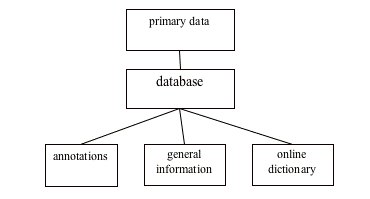The aim of this project is to provide people from various backgrounds (speakers and their political representatives, developers of educational material, NGO’s, language planners, linguists and anthropologists) with a database of the Yurakaré language that can serve a variety of purposes, even purposes we do not foresee at this moment. The database aims in the first place at documenting the Yurakaré language in all its diversity, but it will also include data that give an idea of the context of the language: personal histories, illustrations of everyday practices, Yurakaré testimonies about their own situation and the challenges they are facing today. In this manner we want to build a database that not only includes linguistic material, but that also tries to embed these data in the larger context of the current Yurakaré society.
The general design of the database that we propose can be represented schematically in the following way:

In the database, four levels of description come together. The primary data are video, audio and photo material collected in the field. In the case of video and audio material, the primary data are linked to annotations for each specific session. The annotations include transcriptions, glossing, and translation, but also data related to the context of the recording session like the place of the recording, the type of text (narrative, dialogue, elicitation, etc.), personal information of the persons involved, etc. The annotations are to be connected to an online dictionary, where more lexical, anthropological and grammatical information about specific lexical entries can be found. Finally, we wish to add a section with general information, which would include grammatical, ethnographic, and bibliographic information.
Versatility
Because we want the database to be able to serve many different groups of users, and because we want it to be an adequate representation of the way the Yurakaré language is used, we will try to make the database as versatile as possible. We seek for this versatility in three main aspects:
I. Variety in speech domains
Different speech domains (narratives, dialogues, everyday speech, [official] meetings, procedural texts – e.g. how to make a canoe, or bow and arrows – evangelical sermons, discussions, ritual discourse, elicited material) are associated with different ways of speaking. The importance of including a great variety in types of speech therefore is clear. To give an example, if one wants to study a specific linguistic topic, such as the modal system of a language, one certainly needs a large body of different types of natural texts, but one also needs elicited material, for instance to be able to determine the combinatory (im)possibilities of markers. Even though this example only covers a highly specific research topic, it already shows that a great versatility in text types is highly important.
II. Regional variety
Two major regions can be distinguished in the Yurakaré area (see Geography). The first is situated in the Chapare and Carrasco provinces where the Yurakaré live near a large Quechua-speaking area. This is possibly the most Hispanicized of the areas. The area in between the Rivers Isiboro and Sécure in the National Park and Indigenous Territory Isiboro-Sécure is the second region. In this zone, the Yurakaré share the territory mainly with Trinitarios (Arawak), and further up the Sécure river with Chimane. Although Yurakaré does not seem to have real dialectal subdivisions, there is some regional variety. This variety seems to be restricted mostly to phonetics and the lexicon, but more research is necessary to determine the extent of this regional variation. The two zones can be characterized by the fact that they have different sociolinguistic situations and have had different historical and political developments: the areas have different ethnic neighbors, different representative councils, and the degree of contact and influence by missionary workers in the past and present has not been the same for the inhabitants of both areas. A complicating factor at the level of regional diversity is the constant migration of people and large-scale movements of the Yurakaré in the past.
III. Social variety
Apart from regional variety, variety between speakers can be socially determined. Due to the gradual loss of the language (see Language) there are intergenerational differences within the group of Yurakaré speakers in the manner of speaking and linguistic competence. For example, the system of noun classes in Yurakaré seems to be on its way out, since some of the younger speakers do not make the distinctions that older speakers make anymore. At the level of formalized discourse such as the mythological narratives, which require learned narrating skills, the competent narrators often belong the oldest generation or, when they are younger, to those that have been brought up by their grandparents. Another area associated with variety is gender. In the modal system of Yurakaré, some markers have ‘male’ forms and ‘female’ forms, depending on the gender of the speaker. It furthermore seems to be the case that women tend to use more and different interjections than men, and close investigation may also reveal different prosodic registers for men and women.


